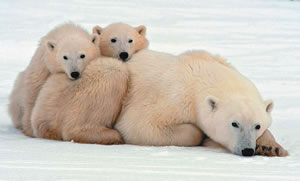Bear Necessities
Business exec Tom Ocasek is fighting to save polar bears as climate change warms up the Arctic Circle and imperils their future on earth. For many Oahu residents, snow is something that
By Brandon Bosworth
E-mail this story | Print this page | Archive | RSS |
 Del.icio.us
Del.icio.us
|
Ocasek, there was something magical about “being in the wild with the largest carnivore in the world in the bleakest climate.”
Since then, Ocasek has made additional trips to photograph polar bears in their chilly native habitat.
But he was not content just to take their pictures. Wanting to do his part to protect these magnificent animals and their imperiled environment, Ocasek became involved with Polar Bears International, a nonprofit organization dedicated to supporting education and research projects that benefit the endangered bears.
“We’re not out to be the biggest,” he explains, “but to stay focused on the polar bears.” Unlike many charitable organizations, nobody involved gets paid: “It’s totally voluntary.” This gives it an edge, according to Ocasek, because it “means 100 percent of every dollar donated goes directly to polar bear projects.” Projects can run the gamut from studies to better understand bear biology to taking accurate census counts of polar bear populations.
Polar Bears International also works to educate young people about the bears and their plight. As part of this effort, the organization arranges for high school students to journey to see polar bears in the wild. Last year, Ocasek helped Punahou student Cassidy Metter take one of these once-in-a-lifetime trips.
“I was impressed by her open-mindedness ... she was well-rounded and had an artistic temperament,” he recalls. “Cassidy brought a human element and sensitivity to the camp.” Besides, who better to understand the fragile environment of the Arctic than someone from the fragile environment of Hawaii?

|
And Ocasek has little doubt that the Arctic is indeed fragile and in jeopardy. Global warming is taking its toll, and “ice we thought would start melting in 50 to 100 years is already melting today.” This has a devastating effect on all wildlife in the region, including polar bears. “Seals, who are the polar bears’ main food source,” he explains, “won’t be on ice flows, because the ice flows have melted or broken away from land.” The bears try to pursue the seals far from land and often end up drowning. Mother polar bears, “who are marvelous teachers,” show their young where to hunt for food, but “by the time the young bears are grown-up, the hunting grounds are gone.” The bears also find their migrations disrupted, as the ice flows they travel across melt away, leaving them stranded in the open sea. Starvation, drowning and even cannibalism are just some of the horrors the bears face as their homes vanish. “The situation for the polar bears right now,” says Ocasek, “is bleak. Should the U.S. government put them on the Endangered Species List? It’s so obvious ... Most of those who know anything about polar bears know they’re endangered.”

|
Ocasek doesn’t work so hard on the bears’ behalf just because of his admitted passion for the animal. He realizes their fates are intertwined with our own: “Animals are a visible weather-vane of what is happening to the environment.”
If the polar bear is dealing with the effects of global warming, dirty air and polluted water now, then so will we in the future. While the political Left and Right are divided currently on environmental matters, Ocasek doesn’t think this always will be the case.
“More alignment will take place as we get closer to a real environmental crisis,” he says. “Politicians will be swept up in the public’s demand for a cleaner environment.”
Of course, people shouldn’t just wait for their leaders to take action, since there are things we all can do in our everyday lives to make things better for not just polar bears and the Earth itself, but for us as well. Ocasek advises “consuming less, recycling and buying recyclables, and using less energy” as starting points. He is optimistic in his belief people will make better choices as they become more aware of what is going on in the world, and sees the growing demand for hybrid automobiles as just one example of changing consumer sensibilities.
Optimism is one of the things that sets Ocasek apart from the gloom-and-doom wing of the environmental movement. He isn’t waiting for the end of the world.
“I always have hope ... Young people are smart, and older people want to leave a better world for our children.”
And for Ocasek, a better world is one where a child can still see a real, live polar bear in the wild.
Page 2 of 2 pages for this story < 1 2
E-mail this story | Print this page | Comments (0) | Archive | RSS
Most Recent Comment(s):








